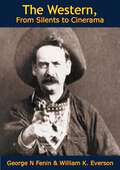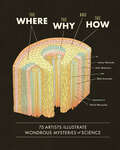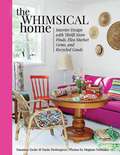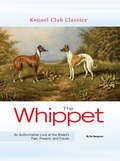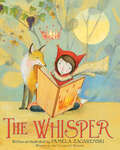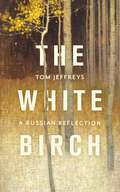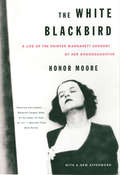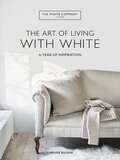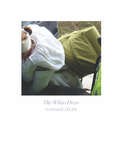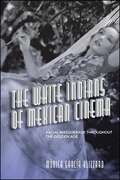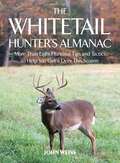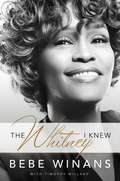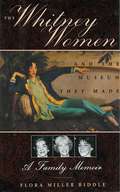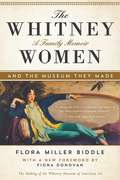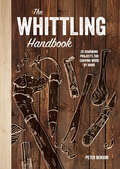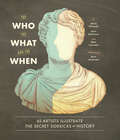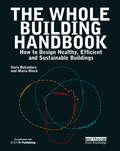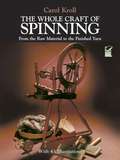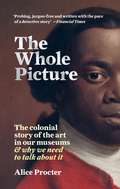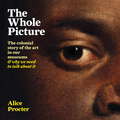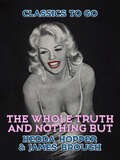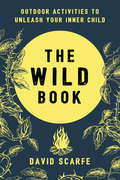- Table View
- List View
The Western: From Silents to Cinerama
by George N Fenin William K. EversonGround-breaking and essential history of the genre, highlighted by superb research, penetrating insights, and sharp, entertaining prose. Smartly designed, with scads of rare b&w photos laid out in a dynamic and witty design.-Print ed.“For many years the Western film has been strangely and unfairly neglected. Although many articles and essays have appeared in general and specialized periodicals all over the world, substantially organic books dealing exclusively with the Western are very rare indeed. And of all this material, the majority has been disguised publicity, or at best essays which refused to take the Western seriously, the work of writers who knew little or nothing of Westerns, writers who glibly referred to the cliché of the hero always kissing his horse instead of the girl, leaving it at that….We felt, therefore, that there was not only room, but a need, for a detailed history of the Western, a book which would represent not only a useful study of the industrial and aesthetic growth of a popular movie genre, but a critical analysis of it, as well. For the most part, we have adopted a strictly chronological approach, but, in the parlance of the film, it has sometimes been necessary to use “flash-forwards and cutbacks” and even a form of montage, in order to follow a thesis through to its logical conclusion.”-Introduction.
The Where, The Why, and The How: 75 Artists Illustrate Wondrous Mysteries of Science
by Matt Lamothe Julia Rothman Jenny VolvovskiIn this New York Times bestseller, “you’ll see star births described in pen and ink, antimatter realized in collage, and a hand-painted black hole” (Discover Magazine).A science book like no other, The Where, the Why, and the How turns loose seventy-five of today’s hottest artists onto life’s vast questions, from how we got here to where we are going. Inside these pages some of the biggest (and smallest) mysteries of the natural world are explained in essays by real working scientists, which are then illustrated by artists given free rein to be as literal or as imaginative as they like. The result is a celebration of the wonder that inspires every new discovery. Featuring work by such contemporary luminaries as Lisa Congdon, Jen Corace, Neil Farber, Susie Ghahremani, Jeremyville, and many more, this is a work of scientific and artistic exploration to pique the interest of both the intellectually and imaginatively curious.“A work of art . . . Pop-science buffs will find the subject matter intriguing, and those who admire graphic novels or comic art will find a plethora of eye candy.” —Publishers Weekly (starred review) “The artists created whimsical illustrations, and the scientists responded with thoughtful essays.” —Smithsonian.com“Seventy-five contemporary artists such as Jacob Magraw, Jen Corace, and Patrick Kyle were commissioned to create the book’s original artwork, leading to a huge variety of visual styles throughout. Some illustrations are, like the front cover pictured above, akin to those of a beautified textbook, but the most are simply works of art; literal, metaphorical, or satiric imagery to accompany the text.” —The Verge
The Whimsical Home: Interior Design with Thrift Store Finds, Flea Market Gems, and Recycled Goods
by Sania Hedengren Susanna ZackeVintage clothing, vintage décor--it simply never gets old and continues to be one of the hottest style trends! Now, you too can create a beautiful vintage home environment that is sure to be the envy all your peers. In The Whimsical Home, master crafters Sania and Susanna show us five different homes furnished with different vintage pieces. Each chapter ends with tips to achieve these fun and whimsical looks. And the best part? None of these exquisite looks will cost you an arm and a leg. Chances are you probably already have a lot of key pieces just lying around your home. Sania and Susanna will show you exactly how to use them. Crafts include: Concrete candle holders A stool decorated with domino pieces A picture made of potholders Follow Sania and Susanna as they travel from home to home, casting in concrete, crocheting, sewing, building, painting, and revamping. Learn how to mix and match unique flea-market finds with modern furniture, and how to reuse old trinkets you may have lying around your house. Be inspired by Sania and Susanna’s expertise and advice. Let your imagination run wild; the sky is the limit. Your house will be beautiful, unique, and the envy of homeowners everywhere.
The Whippet
by Bo BengtsonFifth in the Kennel Club Classics breed series, The Whippet, written by renowned Whippet breeder, judge and historian Bo Bengtson, is the bible on the Whippet, one of the world's most popular and beloved purebred dogs. This book's detailed chapters on everything from the history of the breed to the breed's accomplishments in dog shows around world to the Whippet's participation in racing and coursing events make it the most important and beautiful book ever published on the Whippet. With hundreds of vintage and modern photographs, this book is a must-have for every whippet owner.
The Whisper
by Pamela ZagarenskiThe two-time Caldecott Honor artist shares &“a sumptuously illustrated fable about the magic of storytelling and the power of imagination&” (School Library Journal, starred review). When a little girl receives a curious book filled only with pictures, a whisper urges her to supply the words she cannot see. As the pages turn, her imagination takes flight and she discovers that the greatest storyteller of all might come from within. Pamela Zagarenski&’s debut as an author reminds us that we each bring something different to the same book. "Surreal, staggering mixed-media paintings make traveling across such beautifully varied and bizarre storyscapes exhilarating."—Kirkus, starred review
The White Birch: A Russian Reflection
by Tom Jeffreys'It has been hand-planted by Tsarinas and felled by foresters. It has been celebrated by peasants, worshipped by pagans and painted by artists. It has self-seeded across mountains and rivers and train tracks and steppe and right through the ruined modernity of a nuclear fall-out site. And like all symbols, the story of the birch has its share of horrors (white, straight, native, pure: how could it not?). But, maybe in the end, what I'm really in search of is a birch that means nothing: stripped of symbolism, bereft of use-value . . . A birch that is simply a tree in a land that couldn't give a shit.'The birch, genus Betula, is one of the northern hemisphere's most widespread and easily recognisable trees. A pioneer species, the birch is also Russia's unofficial national emblem, and in The White Birch art critic Tom Jeffreys sets out to grapple with the riddle of Russianness through numerous journeys, encounters, histories and artworks that all share one thing in common: the humble birch tree.We visit Catherine the Great's garden follies and Tolstoy's favourite chair; walk through the Chernobyl exclusion zone and among overgrown concrete bunkers in Vladivostok; explore the world of online Russian brides and spend a drunken night in Moscow with art-activists Pussy Riot, all the time questioning the role played by Russia's vastly diverse landscapes in forming and imposing national identity. And vice-versa: how has Russia's dramatically shifting self-image informed the way its people think about nature, land and belonging?Curious, resonant and idiosyncratic, The White Birch is a unique collection of journeys into Russia and among Russian people.
The White Blackbird: A Life of the Painter Margarett Sargent by Her Granddaughter
by Honor Moore"A striking portrait of a woman artist's struggle for life." --Arthur Miller Margarett Sargent was an icon of avant-garde art in the 1920s. In an evocative weave of biography and memoir, her granddaughter unearths for the first time the life of a spirited and gifted woman committed at all costs to self-expression.
The White Company The Art of Living with White: A Year of Inspiration (White Company)
by Chrissie Rucker Company'I love a home to feel warm, inviting, personal and lived-in - and mastering how to decorate with white and neutrals is a wonderful way to achieve this.''- CHRISSIE RUCKERIn her much-anticipated second book, The Art Of Living With White, Chrissie Rucker, Founder of The White Company, explores 10 inspirational homes that illustrate beautifully different ways to use white and neutrals through the seasons. The homes vary in size, style and location - from a minimalist city pied-à-terre to a New England-style country house - but what unites them all is the welcoming, stylish and calm feel that their owners have each created.The homes are grouped into the four seasons and each chapter ends with a summary of seasonal rituals that will work in any home. A concluding chapter - Inspiration & Resources - considers finding your own style, how to create a good balance between work and home in interior spaces, the art of simple entertaining and the importance of scent and touch in a truly comfortable home.
The White Company The Art of Living with White: A Year of Inspiration (White Company)
by Chrissie Rucker CompanyFrom the author of the home decorating bestseller, For the Love of White, comes an inspirational and informative guide to creating a welcoming home through the seasons using a white and neutral palette.'I love a home to feel warm, inviting, personal and lived-in - and mastering how to decorate with white and neutrals is a wonderful way to achieve this.' - CHRISSIE RUCKERIn her much-anticipated second book, The Art Of Living With White, Chrissie Rucker, Founder of The White Company, explores 10 inspirational homes that illustrate beautifully different ways to use white and neutrals through the seasons. The homes vary in size, style and location - from a minimalist city pied-à-terre to a New England-style country house - but what unites them all is the welcoming, stylish and calm feel that their owners have each created.The homes are grouped into the four seasons and each chapter ends with a summary of seasonal rituals that will work in any home. A concluding chapter - Inspiration & Resources - considers finding your own style, how to create a good balance between work and home in interior spaces, the art of simple entertaining and the importance of scent and touch in a truly comfortable home.Praise for The White Company: For the Love of White'A testament to the power of neutrals' - House and Garden'A visual feast with a passion for all things white at its heart' - House Beautiful
The White Dress
by Nathalie LégerThe third in Nathalie Léger&’s acclaimed genre-defying triptych of books about the struggles and obsessions of women artists. The White Dress is the third in Nathalie Léger's award-winning triptych of books about women who &“through their oeuvre, transform their lives into a mystery&” (ELLE). In Exposition, Léger wrote about the Countess of Castiglione, the most photographed woman of the nineteenth century; in Suite for Barbara Loden she took up the actress and filmmaker Barbara Loden; here, Léger grapples with the tragic 2008 death of Italian performance artist Pippa Bacca, who was raped and murdered while hiking from Italy to the Middle East in a wedding dress to promote world peace. A harrowing meditation on the risks women encounter, in life and in art, The White Dress also brings to a haunting conclusion Léger's personal interrogation—sustained across all three books—of her relationship with her mother and the desire for justice in our lives.
The White House: An Historic Guide (20th edition)
by The Editors of the White House Historical AssociationA guide to the rooms, furniture, and portraits in the White House.
The White Indians of Mexican Cinema: Racial Masquerade throughout the Golden Age (SUNY series in Latin American Cinema)
by Mónica García BlizzardThe White Indians of Mexican Cinema theorizes the development of a unique form of racial masquerade—the representation of Whiteness as Indigeneity—during the Golden Age of Mexican cinema, from the 1930s to the 1950s. Adopting a broad decolonial perspective while remaining grounded in the history of local racial categories, Mónica García Blizzard argues that this trope works to reconcile two divergent discourses about race in postrevolutionary Mexico: the government-sponsored celebration of Indigeneity and mestizaje (or the process of interracial and intercultural mixing), on the one hand, and the idealization of Whiteness, on the other. Close readings of twenty films and primary source material illustrate how Mexican cinema has mediated race, especially in relation to gender, in ways that project national specificity, but also reproduce racist tendencies with respect to beauty, desire, and protagonism that survive to this day. This sweeping survey illuminates how Golden Age films produced diverse, even contradictory messages about the place of Indigeneity in the national culture.This book is freely available in an open access edition thanks to TOME (Toward an Open Monograph Ecosystem)—a collaboration of the Association of American Universities, the Association of University Presses, and the Association of Research Libraries—and the generous support of Emory University and the Andrew W. Mellon Foundation. Learn more at the TOME website, available at: https://www.openmonographs.org/. It can also be found in the SUNY Open Access Repository at http://hdl.handle.net/20.500.12648/7153
The Whitetail Hunter's Almanac: More Than 800 Tips and Tactics to Help You Get a Deer This Season (Lyons Press Ser.)
by John Weiss Peter FiducciaTo take the most impressive whitetail bucks, and to bring them in consistently, a hunter has to know his weapons, the woods and, most of all, his quarry. Now, with The Whitetail Hunter’s Almanac at your side, you too can hunt with the strategies and practical wisdom that master hunter John Weiss has learned during his thirty-plus years on the field. Drawing on years of insider research, data studies, and personal experience, Weiss reveals the never-fail methods to making your shots count.Weiss’s expert whitetail hunting secrets include: Little-known facts about whitetails The perfect places to set up blinds and stands Effective ways to use deer scents How to disappear with camouflage Hunting with a rifle, shotgun, or bow And much more!With careful instructions and more than two hundred photographs to bring the hunt to you, The Whitetail Hunter’s Almanac is the must-have reference to make you a more efficient tracker, woodsman, and consistently successful whitetail hunter. If you love the thrill of outwitting a big buck, The Whitetail Hunter’s Almanac is the guide for you!
The Whitney I Knew
by Timothy Willard BeBe WinansA virtual album of BeBe Winans' treasured memories of his friend and "sister," Whitney Houston. In the years between the first time BeBe Winans and Whitney Houston met in 1985, to the day he delivered the tribute that touched a watching nation at Houston's funeral, a deep and unique friendship bloomed and thrived. They considered each other family in the truest sense of the word.
The Whitney Women and the Museum They Made
by Flora Miller BiddleUntil Gertrude Vanderbilt Whitney opened her studio on Eighth Street in Manhattan in 1914-which evolved into the Whitney Museum almost two decades later-there were few art museums in the United States, let alone galleries, for contemporary artists to exhibit their work. When the mansions of the wealthy cried out for decorative art, they sought it from Europe, then the art capital of the world. It was in her tiny sculptor's studio in Greenwich Village that Whitney began holding exhibitions of contemporary American artists. This remarkable effort by a scion of America's wealthiest family helped to change the way art was cultivated in America. The Whitney Women and the Museum They Made is the story of the high ideals, extraordinary altruism, and great dedication that stood steadfast against inflated egos, big business, and greed. Flora Biddle's sensitive and insightful memoir is a success story of three generations of forceful, indomitable women.
The Whitney Women and the Museum They Made: A Family Memoir
by Flora Miller Biddle Fiona Donovan"Crucial in understanding the evolution of the American art scene.” —Library Journal Until Gertrude Vanderbilt Whitney opened her studio—which evolved into the Whitney Museum almost two decades later—on Eighth Avenue in Manhattan in 1914, there were few art museums in the United States, let alone galleries for contemporary artists to exhibit their work. When the mansions of the wealthy cried out for art, they sought it from Europe, then the art capital of the world. It was in her tiny sculptor’s studio in Greenwich Village that Whitney began holding exhibitions of contemporary American artists. This remarkable effort by a scion of America’s wealthiest family helped to change the way art was cultivated in America. The Whitney Women and the Museum They Made is a tale of high ideals, extraordinary altruism, and great dedication that stood steadfast against inflated egos, big businesses, intrigue, and greed. Flora Biddle’s sensitive and insightful memoir is a success story of three generations of forceful, indomitable women.
The Whittling Handbook: 20 Charming Projects for Carving Wood by Hand
by Peter BensonA refreshed edition of a practical and charming introduction to the time-honored craft of whittling—now with brand-new step-by-step illustrations. Whittling can help you relax even as you create useful and beautiful art with just a knife and some timber. The Whittling Handbook helps beginners explore this time-honored craft and learn foundational skills, from gathering the basic tools to choosing the right wood to keeping your knife sharp. Begin with straightforward projects like a kitchen spatula, and then progress to more complex and intricate items such as a linked chain and a whistle. Easy-to-follow and full of friendly guidance from seasoned woodcarver Pete Benson, this guide is perfect for first-timers.
The Who, the What, and the When: 65 Artists Illustrate the Secret Sidekicks of History
by Matt Lamothe Julia Rothman Jenny VolvovskiStories and portraits of sixty-five unsung heroes behind some of history’s greatest achievements in the arts, politics, science, and technology.Explore the secret stories of the individuals behind some of the most legendary figures in the arts, politics, science, and technology in this fascinating compendium of historical fact and biographical trivia. Learn about Michael and Joy Brown, who gifted Harper Lee a year’s worth of wages to help her write To Kill a Mockingbird. Meet Thomas A. Watson, the assistant who built the telephone Alexander Graham Bell invented. And read about Sam Shaw, the man whose iconic photographs helped make Marilyn Monroe the enduring legend she is today. Each individual’s incredible story is told by a noted historian and illustrated in a sumptuous portrait by one of today’s hottest artists. History has never been so captivating or looked so good.Featuring Artwork By:Wendy MacNaughtonSamantha HahnLaura CallahanThomas DoyleAnd Text by:Jessica Lamb-ShapiroMark BinelliManuel GonzalesJosh Vierteland many more . . . “Sixty-five illustrators and as many writers collaborated for these surprising, fun bios of history’s secret sidekicks, including Mrs. Warhola, who inspired her son Andy’s fascination with groceries.” —mental_floss magazine“A charmingly illustrated compendium of history’s most fascinating—and largely unknown—sidekicks.” —Entertainment Weekly
The Whole Building Handbook: How to Design Healthy, Efficient and Sustainable Buildings
by Maria Block Varis BokaldersThe Whole Building Handbook is a compendium of all the issues and strategies that architects need to understand to design and construct sustainable buildings for a sustainable society. The authors move beyond the current definition of sustainability in architecture, which tends to focus on energy-efficiency, to include guidance for architecture that promotes social cohesion, personal health, renewable energy sources, water and waste recycling systems, permaculture, energy conservation - and crucially, buildings in relation to their place. The authors offer a holistic approach to sustainable architecture and authoritative technical advice, on: * How to design and construct healthy buildings, through choosing suitable materials, healthy service systems, and designing a healthy and comfortable indoor climate, including solutions for avoiding problems with moisture, radon and noise as well as how to facilitate cleaning and maintenance. * How to design and construct buildings that use resources efficiently, where heating and cooling needs and electricity use is minimized and water-saving technologies and garbage recycling technologies are used. * How to 'close' organic waste, sewage, heat and energy cycles. For example, how to design a sewage system that recycles nutrients. * Includes a section on adaptation of buildings to local conditions, looking at how a site must be studied with respect to nature, climate and community structure as well as human activities. The result is a comprehensive, thoroughly illustrated and carefully structured textbook and reference.
The Whole Craft of Spinning: From the Raw Material to the Finished Yarn
by Carol KrollThe ancient craft of spinning is becoming increasingly popular with today's modern craft enthusiasts as it provides a method of creating unique, personal and unusual yarns that can be used in contemporary weaving, knitting, crocheting, needlepoint, embroidery and macramé. It is a highly creative craft, yet simple to learn, and therein lies both its fascination and challenge. The story of spinning is interwoven with the history of man. The first attempt at spinning probably consisted of twisting animal fibers with suitable plant material. Some forms of hand spinning existed as early as 15,000 years ago in Asia, and 12,000 years ago in North Africa. Many of the earliest methods and tools are still in use to this day, especially the various drop spindles, and the Indian and Navajo types of spindles. The spinning wheel itself is believed to have evolved in India 800 to 1,000 years ago.Now you can master this timeless craft through the clear instructions and easy-to-follow directions of well-known spinning authority Carol Kroll. Drawing upon her years of valuable experience, the author shows you everything you need to know from set-up to finished product. You'll learn about the different kinds of spindles and spinning wheels, their history, development, and modern applications. Her lucid text demonstrates the proper methods of preparing the fiber for spinning including: selecting the fiber, sorting, washing, adding oil, and carding.Whether you're a novice or an experienced hand, Carol Kroll's expert advice shows you the ins and outs of: Spinning with a Drop Spindle; Spinning on a Treadle Wheel; Finishing the Yarn; How to Shop for a Spinning Wheel; Spinning with Wool and Making the Most of Natural and Other Animal Fibers; Synthetic Fibers; Making Your Own Spindle; and The Fun of Creating Novelty Yarns.Plus, an access and resources section with suggested further reading, supplies, services, and much more to get you started making something that is truly your own, from the first step to the last.
The Whole Picture: The colonial story of the art in our museums & why we need to talk about it
by Alice Procter"Probing, jargon-free and written with the pace of a detective story... [Procter] dissects western museum culture with such forensic fury that it might be difficult for the reader ever to view those institutions in the same way again. " Financial Times 'A smart, accessible and brilliantly structured work that encourages readers to go beyond the grand architecture of cultural institutions and see the problematic colonial histories behind them.' - Sumaya Kassim Should museums be made to give back their marbles? Is it even possible to 'decolonize' our galleries? Must Rhodes fall?How to deal with the colonial history of art in museums and monuments in the public realm is a thorny issue that we are only just beginning to address. Alice Procter, creator of the Uncomfortable Art Tours, provides a manual for deconstructing everything you thought you knew about art history and tells the stories that have been left out of the canon. The book is divided into four chronological sections, named after four different kinds of art space: The Palace, The Classroom, The Memorial and The Playground. Each section tackles the fascinating, enlightening and often shocking stories of a selection of art pieces, including the propaganda painting the East India Company used to justify its rule in India; the tattooed Maori skulls collected as 'art objects' by Europeans; and works by contemporary artists who are taking on colonial history in their work and activism today.The Whole Picture is a much-needed provocation to look more critically at the accepted narratives about art, and rethink and disrupt the way we interact with the museums and galleries that display it.
The Whole Picture: The colonial story of the art in our museums & why we need to talk about it
by Alice Procter"Probing, jargon-free and written with the pace of a detective story... [Procter] dissects western museum culture with such forensic fury that it might be difficult for the reader ever to view those institutions in the same way again. " Financial Times 'A smart, accessible and brilliantly structured work that encourages readers to go beyond the grand architecture of cultural institutions and see the problematic colonial histories behind them.' - Sumaya Kassim Should museums be made to give back their marbles? Is it even possible to 'decolonize' our galleries? Must Rhodes fall?How to deal with the colonial history of art in museums and monuments in the public realm is a thorny issue that we are only just beginning to address. Alice Procter, creator of the Uncomfortable Art Tours, provides a manual for deconstructing everything you thought you knew about art history and tells the stories that have been left out of the canon. The book is divided into four chronological sections, named after four different kinds of art space: The Palace, The Classroom, The Memorial and The Playground. Each section tackles the fascinating, enlightening and often shocking stories of a selection of art pieces, including the propaganda painting the East India Company used to justify its rule in India; the tattooed Maori skulls collected as 'art objects' by Europeans; and works by contemporary artists who are taking on colonial history in their work and activism today.The Whole Pictureis a much-needed provocation to look more critically at the accepted narratives about art, and rethink and disrupt the way we interact with the museums and galleries that display it.
The Whole Picture: The colonial story of the art in our museums & why we need to talk about it
by Alice ProcterShould museums be made to give back their marbles? Is it even possible to 'decolonize' our galleries? Must Rhodes fall?How to deal with the colonial history of art in museums and monuments in the public realm is a thorny issue that we are only just beginning to address. Alice Procter, creator of the Uncomfortable Art Tours, provides a guide for deconstructing everything you thought you knew about art history and tells the stories that have been left out of the canon. The audiobook is divided into four chronological sections, named after four different kinds of art space: The Palace, The Classroom, The Memorial and The Playground. Each section tackles the fascinating, enlightening and often shocking stories of a selection of art pieces, including the propaganda painting the East India Company used to justify its rule in India; the tattooed Maori skulls collected as 'art objects' by Europeans; and works by contemporary artists who are taking on colonial history in their work and activism today.The Whole Picture is a much-needed provocation to look more critically at the accepted narratives about art, and rethink and disrupt the way we interact with the museums and galleries that display it.(p) 2019 Octopus Publishing Group
The Whole Truth and Nothing But (Classics To Go)
by Hedda HopperFrom the dawn of the studio system to the decade it all came crashing down, Hedda Hopper was one of the Queens of Hollywood. Although she made her name as a star of the silent screen, she found her calling as a gossip columnist, where she had the ear of the most powerful force in show business: the public. With a readership of 20,000,000 people, Hopper turned nobodies into stars, and brought stars to their knees. And in this sensational memoir, she tells all. (Goodreads)
The Wild Book: Outdoor Activities to Unleash Your Inner Child
by David ScarfeIn a world in which we're never far from our phones or tablets, computers or consoles, we can often be blind to the joy that can be found in the great outdoors. We're building worlds in Minecraft when we could be building a raft; we're watching the latest Netflix show when we could be gazing at the stars; we're idly scrolling on social media when we could be strolling through woodlands; we're internet shopping when we could be panning for gold.Our phones may be smarter, but our experiences have shrunk down to the size of the screens in front of our eyes. The Wild Book is here to re-acquaint us with the wonders that await in the outside world. Beautifully produced, full of fun, easy-to-do games and activities - including how to make sloe gin, climb trees, build a fire, identify different cloud formations and make a shelter - this is the ultimate book to unleash your inner child.
